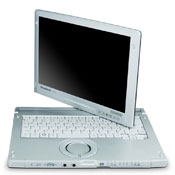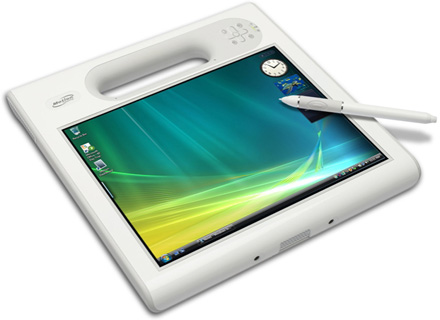Panasonic launches Toughbook C1 for healthcare industry
 At the HIMSS event in Atlanta this week, Panasonic debuted its new 12.1-inch Toughbook C1 convertible tablet, which can withstand a 30-inch drop. The 3.2 pound device runs for five hours on one battery, but can double battery life by adding an additional battery that brings the weight up to 3.5 pounds. The C1 offers a multi-touch screen for fingers and stylus pen data input. The design also includes a new triple hinge design that makes use of two for opening and closing the notebook and a third, separate on enables the device's screen to swivel around from the center. Panasonic says the three hinges will improve that part of the device's durability.
At the HIMSS event in Atlanta this week, Panasonic debuted its new 12.1-inch Toughbook C1 convertible tablet, which can withstand a 30-inch drop. The 3.2 pound device runs for five hours on one battery, but can double battery life by adding an additional battery that brings the weight up to 3.5 pounds. The C1 offers a multi-touch screen for fingers and stylus pen data input. The design also includes a new triple hinge design that makes use of two for opening and closing the notebook and a third, separate on enables the device's screen to swivel around from the center. Panasonic says the three hinges will improve that part of the device's durability.
Wireless and mobility in general is becoming a bigger and bigger theme at HIMSS every year, according to Panasonic's Senior Developer Manager Greg Davidson.
"WiFi is a given for our devices," Davidson said, "but everyone is carrying around cellular data cards, which are easy to lose or liable to break. Our customers are asking for cellular built-in to their devices more and more. They are beginning to see the value of it. Of all our customer groups, though, healthcare is the one with more workers using Toughbooks inside buildings. All the mobility but it's mostly being used indoors. Overall, customers are getting savvier in terms of mobility options. The iPad and other things are getting the industry to talk more about mobility and helping them to understand the benefits of having their data with them no matter where they go -- the patient's bedside, a regional clinic, their car, at home or at the grocery store. The more places they can access the data, the more productive they will be and the better decisions they will make."
"One of the reasons [Panasonic has] done well over all is that we have provided a higher class of device designed specifically for this market," Davidson told MobiHealthNews at HIMSS. "These are not consumer devices and we do not take a 'one-size-fits-all' approach. Doctors, nurses, home health workers -- each have their own specific use case and app preferences. One thing we learned with the Toughbook H1 was that more people are still tied to their keyboards. Touch screen is great for minimal data entry, but anyone doing a good amount of data entry really needs a keyboard," Davidson explained.
"The H1 aside, we discovered that the Mobile Clinical Assistant (MCA) category is probably more of a niche product line than we had thought it was before going into it," Davidson said. "MCAs were certainly something that was completely new before so we couldn't be sure what to expect. Today when people see these devices they know it is the type of device we need to get to eventually. It has the built-in bar code scanner and RFID reader, which are becoming more important, but most are looking to make the safe decision and those are devices with more traditional form factors."
Motion Computing: Healthcare tablets are tools first, PCs second
 "For companies that have never created a tablet (or slate) device before, they will find that it is much more complex and needs to be more integrated than other devices," Motion Computing's Vice President of Marketing Mike Stinson told MobiHealthNews in an interview at HIMSS. "It's certainly easier to tell someone to buy the device with the keyboard just in case. The problem with that is that it is not optimized for healthcare professionals' workflows. Sure, it'd be great to have a 9 pound bullet-proof notebook, but that's just too heavy. These devices need to be balanced and easy to use while resting on the user's forearm. Just putting a mit on the back of one of these devices is not enough. It needs to be ergonomically designed to sit on the user's arm. There are more like tools than PCs."
"For companies that have never created a tablet (or slate) device before, they will find that it is much more complex and needs to be more integrated than other devices," Motion Computing's Vice President of Marketing Mike Stinson told MobiHealthNews in an interview at HIMSS. "It's certainly easier to tell someone to buy the device with the keyboard just in case. The problem with that is that it is not optimized for healthcare professionals' workflows. Sure, it'd be great to have a 9 pound bullet-proof notebook, but that's just too heavy. These devices need to be balanced and easy to use while resting on the user's forearm. Just putting a mit on the back of one of these devices is not enough. It needs to be ergonomically designed to sit on the user's arm. There are more like tools than PCs."
Motion Computing: iPad will train users to get beyond the keyboard
 "We are actually very positive about the iPad or any of the many consumer slates coming out, because they will help people get comfortbale with the idea of not having a keyboard," Stinson said. "Will the iPad come to healthcare? I guarantee you it will. Doctors like the iPhone and the iPad will be right behind it."
"We are actually very positive about the iPad or any of the many consumer slates coming out, because they will help people get comfortbale with the idea of not having a keyboard," Stinson said. "Will the iPad come to healthcare? I guarantee you it will. Doctors like the iPhone and the iPad will be right behind it."
"The iPad is a content consumption device that will enable doctors to review images, including zooming in on and annotating x-rays," Stinson said. "I don't think the iPad is a real data acquisition device," he continued. "Will people bolt on all sorts of medical functionalities? Sure, but look at the iPhone. It has some bar code scanner apps that use its camera, but as soon as the user need to use an iPhone bar code scanner a hundred times a day, you can bet they won't want to do that for too long. So, the iPad will be in the mix and will become part of the workflow but it won't replace slates like [Motion's C5] in the same way that [Motion's slates] haven't replaced desktops."
"We are more than happy to have Apple out there evangelizing slates -- that's great for us," Stinson pointed out.
"The biggest challenge [to the iPad] will come from IT guys at care facilities, because they are going to have some serious issues trying to put iPad on the network and manage it. It's one thing to bring your own smartphone to work and be able to use it, it's another to take it inside and be expected to manage that asset via your IT infrastructure. Devices like the iPad will likely stay around the edge of workflow and remain a data consumption device."
Panasonic: For healthcare, iPad has shortcomings, some promise
"First and foremost the iPad is a consumer device -- that is the big thing," Davidson said. "I have seen a number of studies, though, and by some accounts a good number of physicians are interested. Doctors say it's what they want, but when they go and talk to their IT departments and are told 'it's not running the right operating system;' 'it's not easily sanitizable;' 'it doesn't have the ports we need;' or 'it doesn't run the particular apps we need.' In our experience, our healthcare customers are some of the most demanding users we work with. Remember, healthcare workers are always on the move and are not typically able to sit down and type something up. They are running from room to room and it's very likely they will spill something on their computer or drop it," Davidson said. "The group most interested in the iPad is physicians and based on our experience physicians want a device that is all theirs. They want to be able to take it home at night and use if for personal use, too. They will want it for typing emails and writing documents, and what we have learned is that the more that somebody wants to do with a device like this, the more traditional the form factor needs to be."
"The best things about the iPad are that it is keeps mobility at the forefront of the discussion; it keeps the rest of the industry on our toes; it's a big, big market and there is plenty of opportunity for us all to be successful," Davidson said. "It never hurts to have players in the market who want to move the wheel forward."














